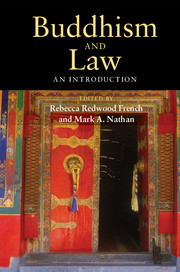Book contents
- Frontmatter
- Dedication
- Contents
- Maps and Illustrations
- Contributors
- Preface
- Abbreviations
- Introducing Buddhism and Law
- Part I The Roots of Buddhism and Law in India
- Part II Buddhism and Law in South and Southeast Asia
- 6 Buddhism and Law in Sri Lanka
- 7 Flanked by Images of Our Buddha
- 8 The Legal Regulation of Buddhism in Contemporary Sri Lanka
- 9 Pāli Buddhist Law in Southeast Asia
- 10 Genres and Jurisdictions
- Part III Buddhism and Law in East Asia
- Part IV Buddhism and Law in North Asia and the Himalayan Region
- A Selection of Readings
- Index
- References
10 - Genres and Jurisdictions
Laws Governing Monastic Inheritance in Seventeenth-Century Burma
Published online by Cambridge University Press: 05 August 2014
- Frontmatter
- Dedication
- Contents
- Maps and Illustrations
- Contributors
- Preface
- Abbreviations
- Introducing Buddhism and Law
- Part I The Roots of Buddhism and Law in India
- Part II Buddhism and Law in South and Southeast Asia
- 6 Buddhism and Law in Sri Lanka
- 7 Flanked by Images of Our Buddha
- 8 The Legal Regulation of Buddhism in Contemporary Sri Lanka
- 9 Pāli Buddhist Law in Southeast Asia
- 10 Genres and Jurisdictions
- Part III Buddhism and Law in East Asia
- Part IV Buddhism and Law in North Asia and the Himalayan Region
- A Selection of Readings
- Index
- References
Summary
The interrelationships between Buddhism and law in Southeast Asian history are dynamic and untidy: different legal and scriptural genres borrow from and blend into others; authority is invoked from multiple (and at times seemingly contradictory) sources; jurisdictions of monastic and lay law overlap or conflict. Multiple ideologies of law, their normative expression in texts, or their implementation in practice, are not in any straightforward sense “Buddhist,” much less “Theravādan.” These latter terms are meant to signify some sort of allegiance to the Pāli Vinaya and its Mahāvihārin commentaries. Although these literatures were deeply influential, Southeast Asian historical discourses of Buddhism and Law, and indeed even “Buddhist law” in its strongest definition as Vinaya, must be approached as works-in-progress, as contingent convergences, effects of an ongoing dialogue between legists and changing textual, intellectual, and religio-political horizons.
This article examines laws governing the inheritance of monastic property and discourse about such law, expressed in the two principle vernacular and Pāli genres of written law in circulation in seventeenth-century Burma: Vinaya and dhammasattha. Calling into question any strict divide between lay and monastic legal spheres, it shows that monastic inheritance did not fall under the exclusive jurisdiction of Vinaya, and also that Vinaya laws regulating monastic partition were appropriated by dhammasattha for application to the lay community. The former point underscores the need to historicize Vinaya practice and theory as part of broader legal-textual cultures. The latter point addresses the degree to which Vinaya might serve as a source of non-monastic law in Southeast Asia.
- Type
- Chapter
- Information
- Buddhism and LawAn Introduction, pp. 183 - 198Publisher: Cambridge University PressPrint publication year: 2014
References
- 2
- Cited by



